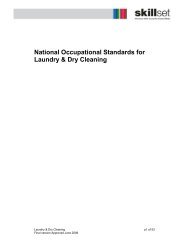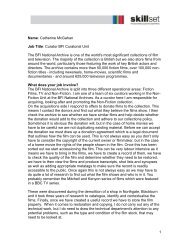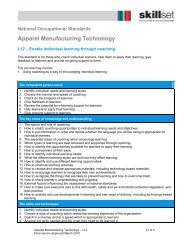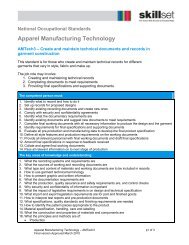Publishing in the Knowledge Economy - DTI Home Page
Publishing in the Knowledge Economy - DTI Home Page
Publishing in the Knowledge Economy - DTI Home Page
You also want an ePaper? Increase the reach of your titles
YUMPU automatically turns print PDFs into web optimized ePapers that Google loves.
The <strong>in</strong>dustry today<br />
<strong>Publish<strong>in</strong>g</strong> <strong>in</strong> <strong>the</strong> knowledge economy<br />
companies to develop cross-platform<br />
strategies and to escape from rigid crossmedia<br />
ownership constra<strong>in</strong>ts.<br />
However, accord<strong>in</strong>g to a Henley Centre study<br />
for <strong>the</strong> Publishers’ Association, on how book<br />
publish<strong>in</strong>g is far<strong>in</strong>g <strong>in</strong> relation to o<strong>the</strong>r media,<br />
while time spent on media <strong>in</strong> total is not ris<strong>in</strong>g,<br />
<strong>the</strong> percentage of total time spent read<strong>in</strong>g is<br />
be<strong>in</strong>g apportioned differently, with <strong>the</strong> share of<br />
books ris<strong>in</strong>g (up from 44% <strong>in</strong> 1988 to 52% <strong>in</strong><br />
2000) and <strong>the</strong> share of newspapers (down from<br />
44% to 32%) fall<strong>in</strong>g. Magaz<strong>in</strong>es’ share rose<br />
from 1988 to 1998 (13% to 22%) but has s<strong>in</strong>ce<br />
fallen to 16%.<br />
Interest<strong>in</strong>gly, <strong>in</strong> contrast with Mediaphile, <strong>the</strong><br />
Henley Centre also found that <strong>the</strong> proportion of<br />
time spent read<strong>in</strong>g has risen relative to o<strong>the</strong>r<br />
leisure activities, while time spent listen<strong>in</strong>g or<br />
view<strong>in</strong>g has fallen, albeit slightly. The sharpest<br />
rise, unsurpris<strong>in</strong>gly, is <strong>in</strong> <strong>the</strong> proportion of time<br />
spent ‘<strong>in</strong>teract<strong>in</strong>g’.<br />
One of <strong>the</strong> questions asked <strong>in</strong> our survey of<br />
<strong>in</strong>dustry companies (see Appendices for<br />
methodology and text of <strong>the</strong> questionnaire)<br />
related to <strong>the</strong> impact of various k<strong>in</strong>ds of social<br />
changes on <strong>the</strong> <strong>in</strong>dustry. The results suggest<br />
that <strong>the</strong> <strong>in</strong>creased demands on consumers’<br />
time constitutes <strong>the</strong> most negatively perceived<br />
aspect of anticipated social changes (see<br />
Figure 3.10). It is also important to note that this<br />
<strong>in</strong>formation refers only to consumer media<br />
spend<strong>in</strong>g and use, not to <strong>the</strong> bus<strong>in</strong>ess to<br />
bus<strong>in</strong>ess area.<br />
3.5 Demographic changes<br />
The age profile of <strong>the</strong> population has major<br />
implications for <strong>the</strong> publish<strong>in</strong>g <strong>in</strong>dustry. The<br />
current trend towards <strong>the</strong> age<strong>in</strong>g of <strong>the</strong><br />
population is ma<strong>in</strong>ly seen as positive or neutral,<br />
accord<strong>in</strong>g to our questionnaire.<br />
This is backed up by research which shows<br />
that, for books and newspapers at any rate, <strong>the</strong><br />
usage is skewed towards older age groups.<br />
This would imply a positive outlook for those<br />
sectors because of <strong>the</strong> age<strong>in</strong>g of <strong>the</strong> population.<br />
However, unless this pattern is reproduced as<br />
generations mature, it is obvious that publish<strong>in</strong>g<br />
companies will eventually be <strong>in</strong> difficulty.<br />
Because newspapers have actually<br />
experienced decl<strong>in</strong><strong>in</strong>g circulations – not just <strong>in</strong><br />
<strong>the</strong> UK, but across <strong>the</strong> advanced countries –<br />
Table 3.1 Newspaper readership<br />
profiles by age<br />
Age<br />
group National Regional<br />
15-24 13.5 13.9<br />
25-34 17.4 18.1<br />
35-44 17.8 18.4<br />
45-54 17.5 16.6<br />
55-64 13.5 13.1<br />
65+ 20.2 19.8<br />
Source BMRB Target Group Index (TGI) 2001<br />
<strong>the</strong>y have tended to be more concerned about<br />
this issue than o<strong>the</strong>r segments. The Newspaper<br />
Society carried out some research with BMRB<br />
<strong>in</strong>to media use by lifestage, which shows very<br />
clearly how <strong>the</strong> different stages of life, e.g. ‘live<br />
with parents’, ‘live with partner’, ‘children left<br />
home’, affect <strong>the</strong> k<strong>in</strong>d of media that is used and<br />
how <strong>in</strong>tensively. This lifestage analysis is<br />
<strong>in</strong>creas<strong>in</strong>gly more useful than simple age<br />
breakdowns, now that family formation occurs<br />
at very vary<strong>in</strong>g ages, and second families are<br />
becom<strong>in</strong>g more common.<br />
A particular problem faces national<br />
newspapers <strong>in</strong> that <strong>the</strong>y have a limited number<br />
of brands at <strong>the</strong>ir disposal and <strong>the</strong>se brands<br />
tend to become identified with particular age<br />
cohorts, with well-known examples be<strong>in</strong>g <strong>the</strong><br />
Daily Express and <strong>the</strong> Daily Telegraph.<br />
Theoretically <strong>in</strong>teractive media present great<br />
opportunities for publish<strong>in</strong>g companies to break<br />
free of <strong>the</strong> format and brand constra<strong>in</strong>ts that can<br />
prevent <strong>the</strong>m appeal<strong>in</strong>g to new generations of<br />
customers. In practice, it has been difficult so far<br />
to deploy <strong>the</strong> power of <strong>the</strong> offl<strong>in</strong>e brand to<br />
support <strong>the</strong> onl<strong>in</strong>e one at <strong>the</strong> same time as<br />
hav<strong>in</strong>g enough flexibility <strong>in</strong> <strong>the</strong> onl<strong>in</strong>e brand to<br />
allow it to play <strong>the</strong> desired role of a new,<br />
differentiat<strong>in</strong>g identity. Closely related to this is<br />
<strong>the</strong> issue of monetis<strong>in</strong>g <strong>the</strong> onl<strong>in</strong>e manifestation<br />
of <strong>the</strong> brand, apart from by driv<strong>in</strong>g sales or ><br />
17

















